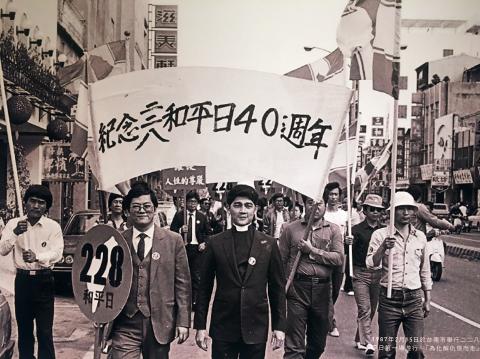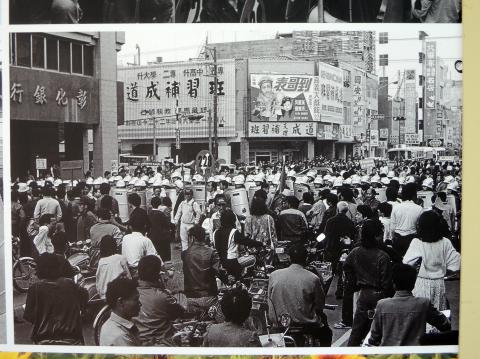Feb. 27 to March 5
“Today, the family of the victims will listen with their own ears as I, as a public servant of the country, accept the responsibilities of the government’s past mistakes and offer my deepest apologies.”
These words were part of the speech by then-president Lee Teng-hui (李登輝) on Feb. 28, 1995, the 48th anniversary of the anti-government uprising and subsequent brutal crackdown that would be known as the 228 Incident.

Photo: Hung Jui-chin, Taipei Times
It was the first time a president officially addressed the incident, much less apologized for it, as the incident had remained a taboo subject well into the 1980s. Even after the lifting of martial law, artist Chan San-yuan (詹三原) was reportedly jailed (under other pretenses) for designing Taiwan’s first 228 memorial monument in Chiayi in 1989.
CENSORING 228
To understand the extent the incident was “erased” from public memory, communications professor Hsia Chun-hsiang (夏春祥) analyzed news reports from the Taiwan Shin Sheng Daily News (台灣新生報), United Daily News (聯合報) and China Times (中國時報) between 1947 and 2000.

Photo: Hung Jui-chin, Taipei Times
Between 1948 and 1957, only four news articles mentioning the 228 Incident appeared in these papers, all of them appearing in the government-run Taiwan Shin Sheng Daily News. One of these detailed the punishments for those involved in the uprising, and the other three were direct reports on notable people involved with the incident.
After 1957, the 228 Incident disappeared from these papers for 27 years until the United Daily News published a feature on the history of the Central News Agency, which mentions how staff members reacted during the incident.
In 1985, legislator Chiang Peng-chien (江鵬堅) requested that the government acknowledge and apologize for the incident, suggesting that they designate Feb. 28 as “Peace Day.” The Executive Yuan did not respond and major newspapers did not report on the matter.
Two days before the 40th anniversary of the event in 1987, the first critical article appeared in the United Daily News, a column by historian Hsu Cho-yun (許倬雲) asking the government to directly address and resolve the “228 tragedy.”
Martial law was lifted a few months later, and freedom of speech began to return. By 1992, a United Daily News poll showed that 80 percent of respondees knew about the incident.
INTO THE SPOTLIGHT
Despite official censorship, Taiwanese kept the memory of the 228 Incident alive in private. And since the 1950s, independence activists working in Japan and the US continued to make the incident one of their talking points.
According to the article The Predicament of Historical Justice: Ethnic Issues and the Discourses on the 228 Uprising by historian Chen Tsui-lien (陳翠蓮), overseas Taiwanese published books in 1983 and 1984 that heavily criticized the KMT’s handling of the events.
The government dismissed these authors as instigators who were reopening old wounds to advance their independence agenda. They decided to write their own book, which contained the following passage:
“After the incident, the government and people both stopped talking about the events because of how painful it is to everyone …We only hope that time can wash away these horrific memories and people can stop debating which facts are true and who was in the wrong ... Otherwise it will only disturb our peaceful life as a united people. These overseas groups bring this event up each year to slander the government and distort the truth.”
In February 1987, local activists started the 228 Peace Day Association ( 二二八和平日促進會) and started holding memorials all over the country. Although riot police were sent to stop them, the activities continued. Chen writes that the government at this point finally realized that they could no longer brush the incident aside.
At first, officials continued the rhetoric of “needlessly reopening old wounds,” but after the end of martial law, more legislators spoke out and the media reports only continued to increase, although Chen writes that much of the content echoed that of the government.
When Lee became president in 1988, he too stated that people should bury the hatchet and look toward the future instead of the past. By 1990, his stance had changed, establishing a 228 Incident Task Force and allowing the events to be included into high school textbooks for the first time.
However, the family of the victims and 228 activists were not satisfied especially because their calls for the government to formally apologize were repeatedly denied.
After his 1995 apology, Lee added that this was just the beginning.
“We can’t be satisfied with building this monument,” he said. “We need to publicize the truth behind the events, compensate the victims, designate a memorial day, and also heal our people’s spirits and rebuild their dignity. These will all happen in the near future.”
Taiwan in Time, a column about Taiwan’s history that is published every Sunday, spotlights important or interesting events around the nation that have anniversaries this week.

In recent weeks the Trump Administration has been demanding that Taiwan transfer half of its chip manufacturing to the US. In an interview with NewsNation, US Secretary of Commerce Howard Lutnick said that the US would need 50 percent of domestic chip production to protect Taiwan. He stated, discussing Taiwan’s chip production: “My argument to them was, well, if you have 95 percent, how am I gonna get it to protect you? You’re going to put it on a plane? You’re going to put it on a boat?” The stench of the Trump Administration’s mafia-style notions of “protection” was strong

Every now and then, it’s nice to just point somewhere on a map and head out with no plan. In Taiwan, where convenience reigns, food options are plentiful and people are generally friendly and helpful, this type of trip is that much easier to pull off. One day last November, a spur-of-the-moment day hike in the hills of Chiayi County turned into a surprisingly memorable experience that impressed on me once again how fortunate we all are to call this island home. The scenery I walked through that day — a mix of forest and farms reaching up into the clouds

With one week left until election day, the drama is high in the race for the Chinese Nationalist Party (KMT) chair. The race is still potentially wide open between the three frontrunners. The most accurate poll is done by Apollo Survey & Research Co (艾普羅民調公司), which was conducted a week and a half ago with two-thirds of the respondents party members, who are the only ones eligible to vote. For details on the candidates, check the Oct. 4 edition of this column, “A look at the KMT chair candidates” on page 12. The popular frontrunner was 56-year-old Cheng Li-wun (鄭麗文)

Oct. 13 to Oct. 19 When ordered to resign from her teaching position in June 1928 due to her husband’s anti-colonial activities, Lin Shih-hao (林氏好) refused to back down. The next day, she still showed up at Tainan Second Preschool, where she was warned that she would be fired if she didn’t comply. Lin continued to ignore the orders and was eventually let go without severance — even losing her pay for that month. Rather than despairing, she found a non-government job and even joined her husband Lu Ping-ting’s (盧丙丁) non-violent resistance and labor rights movements. When the government’s 1931 crackdown